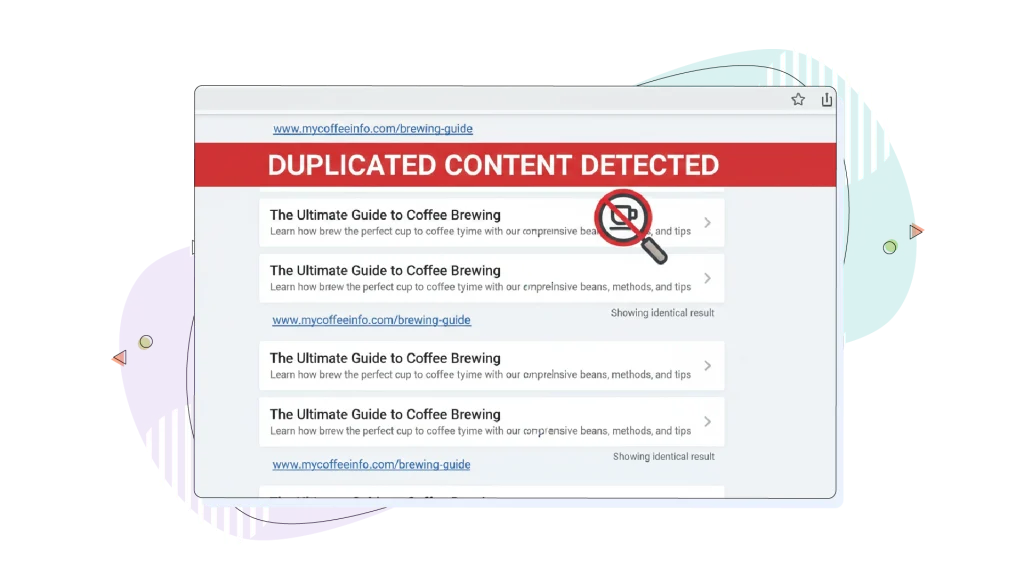It’s not unusual for content to appear in multiple places online—on websites, social media, syndication platforms, and beyond. A well-crafted blog post, company story, or product description is sometimes so hard to create that when you come across one, it’s tempting to use it everywhere.
But how does duplicate content actually affect your SEO?
This article analyzes the impact of duplicate content on your website’s search engine results and search engine rankings, enabling you to understand why managing it is so meaningful.
Here’s some good news before we start: Duplicate content isn’t inherently bad for your SEO. But if you don’t handle it mindfully, it can dilute your ranking potential, confuse search engines, impact your visibility in search engine results and search engine rankings, and waste a valuable crawl budget.
- What Is Duplicate Content?
- Does Duplicate Content Hurt SEO? The Truth
- How Duplicate Content Actually Impacts Rankings
- The Real Impact: Search Visibility
- Why Duplicate Content Matters for SEO
- Internal & External Duplicate Content Issues
- How to Find Duplicate Content on Your Site
- How to Fix Duplicate Content: Technical Solutions
- Duplicate Content Best Practices
Blog Highlights:
Duplicate content doesn’t have to be a source of stress, but rather an opportunity to iron out the content of your website:
- There is no duplicate content penalty in the way most people imagine. Google filters duplicates rather than penalizing sites for having them.
- Internal duplicate content should be minimized through canonical tags, 301 redirects, or consolidation.
- External duplicate content is acceptable when properly managed with canonical tags and clear attribution.
- The real harm comes from losing control of which pages rank for your keywords, not from Google’s disapproval.
- Prevention is easier than remediation: Implement technical safeguards and content guidelines from the start.

What Is Duplicate Content?
Causes of Duplicate Content Issues
Duplicate content consists of substantive blocks of content that appear in multiple locations online, either on the same website or across different domains. Search engines define it as content that is identical or appreciably similar across different URLs.
These issues often result in identical pages containing the same content and information, which can negatively impact SEO in other ways. Duplicate content exists for three main reasons:
- It was created intentionally. You may republish your blog on Medium, syndicate content to industry publications, or reuse your value proposition across multiple pages. In these cases, the same content and information are distributed across different platforms or URLs.
- It’s a side effect of website mismanagement. eCommerce sites generate duplicate URLs through product parameters, filtering options, or multiple category placements. CMS systems create duplicate archives. Site structures with www and non-www versions, or HTTP and HTTPS, can double your content on the same site. These technical issues can lead to identical pages being accessible through different URLs.
- It results from plagiarism or content scraping. Competitors may copy your content without permission, or content aggregators scrape your pages. This is another common cause of duplicate content.
Internal vs External Duplicate Content
Understanding the difference between these two types is critical for your SEO strategy.
Internal duplicate content occurs within your own website when the same or very similar content appears on multiple pages. These issues happen across your website’s pages. Examples include:
- Product descriptions are repeated across different category pages.
- Blog posts are appearing in multiple archive versions.
- Boilerplate text is used identically on every page.
- Shipping policies, warranty statements, or legal disclaimers are duplicated on every product page.
The problem intensifies when this redundancy extends to metadata tags and URLs, which can confuse search engines about which version deserves to rank.
External duplicate content happens when your content appears on other websites. This occurs through:
- Intentional syndication (publishing on Medium, LinkedIn, industry sites).
- Guest blogging on other domains.
- Manufacturers’ product descriptions appear across multiple retailer websites.
- Content scraping by competitors or content aggregators.
- Unintentional plagiarism.

Does Duplicate Content Hurt SEO? The Truth
Duplicate content has long been a confusing topic for website owners, largely because myths about duplicate content penalties persist despite being officially debunked.
The term SEO duplicate content often comes up in these discussions, referring to how duplicate content—whether internal or external—can impact your search engine rankings. Let’s address the reality directly.
The Duplicate Content Penalty Myth
Many site owners worry that duplicate content violates Google’s guidelines and will result in manual penalties. In reality, this concern is unfounded.
Google’s former webspam team lead explicitly stated: “Let’s put this to bed once and for all, folks: There’s no such thing as a ‘duplicate content penalty.’ At least, not in the way most people mean when they say that.” Google has reiterated this stance consistently over more than a decade.
Google only issues penalties when duplicate content is used with deceptive intent to manipulate search engine results or mislead users. You can use duplicate content with legitimate intent in scenarios like:
- eCommerce product listings with multiple variants.
- Printer-friendly versions of web pages.
- Canned postings for discussion forums or syndication.
- Mobile and desktop versions of pages.
- Multiple language versions with proper hreflang tags.
Google’s official position is clear: content duplication of this kind doesn’t negatively impact your SEO.
When Google Takes Action
The only exception is in extreme cases where duplicated content is deliberately used to manipulate rankings and deceive users. If Google discovers this behavior—such as massive content scraping operations, doorway page schemes, or templates designed to exploit search results with duplicated content—the search engine will lower the rankings of the sites involved.
This is important to understand: Google penalizes the intent to manipulate, not the mere existence of duplicates.

How Duplicate Content Actually Impacts Rankings
While there’s no direct penalty, duplicate content creates real challenges that indirectly harm your SEO performance and search rankings:
Internal duplicate content can make search engines index the wrong page. Crawlers from Google can get confused when they find the exact same content on multiple pages. Repetitive metadata tags, boilerplate text on every page, and a redundant URL structure across many categories can lead Google to return the wrong page for a keyword search—and you have no control over which version they choose.
This confusion is especially common when the exact same content appears across different pages of your website. If you’re considering how different marketing strategies like PPC and SEO can impact your website’s visibility, it’s important to understand these differences as well.
External duplicate content divides your link authority. When your content appears on multiple sites without proper canonical tags, the links pointing to different versions don’t consolidate. Instead of one powerful page, you have several weaker ones. Consolidating duplicate content into one page helps build authority and improve SEO focus.
Duplicate content wastes your crawl budget. Search engines allocate a finite crawl budget to each website. When crawlers spend time on duplicate pages, they have less capacity to discover and index your important content.
The Real Impact: Search Visibility
The biggest downside to mismanaged duplicate content is that it can cause search engines to link to the wrong page for a given keyword.
Duplicate content is important because it can confuse search engines, dilute your rankings, and cause issues with site visibility. Imagine ranking position #1 for an important keyword—except the wrong version of your page ranks instead of your preferred version.
That’s the genuine harm of unmanaged duplicate content: not a penalty, but control lost over which of your pages appears in search results, and the SEO value they receive.

Why Duplicate Content Matters for SEO
Understanding the specific ways duplicate content affects your SEO performance helps you see why managing it strategically is worth the effort.
In the next section, we’ll show you how to fix duplicate content issues to protect your rankings and website authority.
Ranking Dilution & Keyword Cannibalization
When multiple pages on your site target the same keywords with similar content, they compete against each other in search results. This phenomenon, called keyword cannibalization, forces search engines to choose between your pages rather than consolidating their ranking power into a single authoritative resource.
When this happens, the link equity from each site’s link—meaning backlinks from other websites—gets divided among the duplicate pages, diluting the overall authority and making it harder for any single page to rank well.
The impact is measurable. When websites consolidate cannibalized pages through 301 redirects, they frequently see traffic increases of 100—400% over several weeks.
Confusing Search Results
When search results display multiple similar pages from the same website, users struggle to determine which is the correct or most relevant version. This creates friction and reduces click-through rates.
Users landing on the wrong duplicate page may not find the particular page they need, leading to higher bounce rates and lower engagement.
Crawl Budget Waste
For large websites with thousands of pages, duplicate content becomes particularly problematic. Your crawl budget—the number of pages Google will crawl in a given period—is finite.
Duplicate content pages waste crawl budget by causing search engine crawlers to spend resources on unnecessary or repetitive pages. Every page crawled is a page Google cannot crawl. When crawlers spend time on duplicates, your new or recently updated important pages may go uncrawled and unindexed for longer.
Optimizing your website content for SEO can help prevent these issues.
Link Equity Fragmentation
Backlinks are one of the most important ranking factors. When your content appears in multiple places, links pointing to different versions divide your link authority rather than consolidating it. A single page with all links pointing to it is more powerful than five pages with links distributed among them.

Internal & External Duplicate Content Issues
Let’s examine specific problems you may encounter with each type of duplication.
Internal duplicate content refers to identical or very similar content appearing on multiple pages within the same website. External duplicate content, on the other hand, occurs when identical or nearly identical content is found across different websites.
This can happen, for example, when your content is syndicated or scraped and published on other domains, leading to SEO challenges.
Internal Content Duplication
Internal duplication results from several sources: multiple versions of your site, your site’s page organization, or unnecessary boilerplate text.
Common causes include:
- Boilerplate redundancy: Shipping policies, warranty statements, and footer text appearing identically on dozens or hundreds of pages.
- Product variations: The same product appearing under multiple URLs for different sizes, colors, or category placements, which can result in separate pages with nearly identical content.
- Archived content: Blog posts accessible through multiple archive paths or category pages.
- Session IDs and parameters: URL tracking codes and other tracking parameters create unique URLs for identical content, even though the underlying page is the same URL.
- Template repetition: CMS templates create excessive similarity across pages.
The solution for boilerplate content: Replace identical text with links to centralized detail pages. Instead of repeating your shipping policy on every product page, link to a single comprehensive shipping policy page. This preserves the information users need while eliminating redundancy.
The solution for categorical organization: Use canonical tags to point all category variations of a product back to the primary product page. This keeps all URLs accessible while telling search engines which deserve the ranking.
Another dimension of internal duplication involves repurposing your messages in too many places on your site. While not technically a search penalty, this creates a poor user experience. Repetitive content adds no value and detracts from how users perceive your site’s quality and professionalism.
External Content Duplication
When multiple versions of your content appear around the web, it’s because you intended it that way or because someone stole it. Each scenario requires different handling.
Intentional Content Duplication
Your website is the center of your content strategy, but that content must reach a broader audience. Guest blog posts, Medium publications, LinkedIn articles, and other platforms are high-visibility channels for spreading your message.
The best approach to intentional duplication:
- Leverage multiple channels strategically: Publish on high-authority platforms to reach new audiences.
- Add unique value to each channel: Adapt your message slightly for each platform rather than copying verbatim.
- Use canonical tags on syndicated content: Request that publishing partners add a canonical tag pointing back to your original article. When syndicating, make sure the correct article url is specified in the canonical tag to help search engines identify the original source.
- Include clear attribution: At a minimum, include a link back to your original content.
- Don’t overthink social media: Search engines index social media content differently from web content. Posting the same message on LinkedIn, Twitter, and Facebook won’t harm your SEO.
Content Scraping & Plagiarism
Finding out your content has been stolen is frustrating. You discover an unfamiliar link to your latest blog post in the search console, click it, and find a word-for-word copy with no attribution. Often, your content may appear on other sites without your permission, which can impact your SEO and brand reputation.
How to respond:
Pursue legal action if the infraction is severe:
- Your entire website has been copied.
- A close competitor publishes barely edited versions of your content.
- A high-authority site is systematically scraping your content.
- As the website owner, you are responsible for initiating legal action or submitting takedown requests to protect your intellectual property.
Consider ignoring minor infractions:
- A new website with low SEO authority grabbed a portion of your content.
- A small blog republished one article without permission.
Why ignore it? Because your site is the canonical version. Google recognizes which site published first and will rank your original higher. The scraper site will rank lower—partly because it has lower authority, and partly because Google understands the original-duplicate relationship.
Use Google Search Console to monitor:
- Search for distinctive phrases from your content using the site: operator.
- Regularly check your site’s links in Google Search Console.
- Set up Google Alerts for your brand name and key phrases.

How to Find Duplicate Content on Your Site
Before fixing duplicate content, you need to identify duplicate content across your website to clarify where the issues are. Here are practical methods for detecting duplicates.
When reviewing your site, be sure to identify duplicate content issues such as repeated pages, titles, or meta descriptions that can negatively impact your SEO.
To streamline this process, consider using a site audit tool for a comprehensive analysis and to help uncover duplicate content throughout your site.
Manual Checking Methods
The simplest approach uses Google itself. Copy a distinctive sentence or paragraph from your page, put it in quotation marks, and search:
“Your distinctive phrase goes here.”
To check only your own site, use the site: operator:
site: yourdomain.com “your distinctive phrase”
If multiple pages from your site appear, you have internal duplicate content.
Another manual method: Compare the number of pages you’ve created versus the number Google has indexed. In Google Search Console, navigate to Indexing > Pages to see how many URLs are in Google’s index. If this number is higher than your expected page count, duplicate content may be the culprit.
Free Tools to Help You Find Duplicate Pages
Google Search Console is your first line of defense. The Pages report identifies duplicate-related warnings, including:
- “Duplicate without user-selected canonical.”
- “Duplicate, Google chose a different canonical than the user.”
- “Duplicate, submitted URL not selected as canonical.”
Access these by navigating to Pages under the Indexing section, then scrolling to Why pages aren’t indexed.
Siteliner (free version) scans up to 250 pages of your website for internal duplicate content, analyzing titles, headings, and content blocks with a comprehensive report showing exactly which pages duplicate each other.
Copyscape helps you find external duplicate content by searching the web for copies of your content. The free version checks individual pages; the premium version offers batch checking and ongoing monitoring.
Premium Tools for Comprehensive Analysis
Semrush site audit flags pages with 85% or more content similarity as duplicates, providing detailed reports that identify duplicate title tags, meta descriptions, and content blocks, and checks for the presence of the canonical HTML tag to confirm proper canonicalization.
Ahrefs’ site audit includes a dedicated Content Quality report that clusters duplicate and near-duplicate pages, distinguishing between good duplicates (properly handled with canonical tags) and bad duplicates (lacking proper canonicalization).
Screaming Frog SEO Spider crawls your website and identifies exact and near-duplicate pages, detecting duplicate titles, meta descriptions, H1 tags, and content with similarity calculations.
Step-By-Step Detection Process
- Run a comprehensive crawl using your chosen tool to scan your entire website.
- Review the duplicate content report to identify clusters of similar pages.
- Investigate the root cause: Are duplicates stemming from URL parameters, content management issues, or other factors?
- Prioritize fixes by focusing on pages that generate traffic or target important keywords.
- Document your findings in a spreadsheet listing duplicate URLs and your recommended action for each.

How to Fix Duplicate Content: Technical Solutions
Once you’ve identified duplicate content, you need to resolve it strategically. One very common solution is to implement a canonical url, which specifies the preferred version of a web page and helps search engines consolidate link signals while preventing duplicate content issues. The right approach depends on whether you need both versions accessible or not.
301 Redirects: For Permanent Consolidation
A 301 redirect permanently redirects users and search engines from one URL to another. This is the strongest solution when you want to consolidate duplicate content because it:
- Consolidates link equity to the target URL.
- Removes the old URL from the index over time.
- Provides a seamless experience for users.
When to use 301 redirects:
- The duplicate page is no longer needed.
- You’re consolidating multiple similar pages into one, which can be an opportunity to focus your link-building efforts on a single, authoritative source.
- You’re moving content permanently to a new URL.
- The pages are genuinely equivalent.
Example implementation:
For Apache servers (.htaccess file):
Redirect 301 /old-page.html https://example.com/new-page.html
For Nginx servers:
location /old-page.html { return 301 https://example.com/new-page.html; }
Important considerations: 301 redirects pass approximately 90—99% of link equity to the target page, making them the most effective solution for consolidating ranking power.
Canonical Tags: For Keeping Multiple Versions Accessible
A canonical tag is an HTML element—also known as a canonical link or canonical link element—that specifies the preferred version of a page when duplicates exist. Unlike redirects, canonical tags keep both URLs accessible while signaling to search engines which to prioritize.
When to use canonical tags:
- You need both versions accessible to users.
- URL parameters create duplicate content.
- Product pages appear under multiple categories.
- You’re syndicating content to other websites.
- You want to maintain tracking or user preference URLs.
- You have a print-friendly version of your page that may be indexed as duplicate content.
Example implementation:
Add this code to the <head> section of duplicate pages:
For more on growing your website through effective strategies, check out these content marketing tips for small businesses.
< link rel=”canonical” href=”https://example.com/preferred-page” />
This HTML code is called a canonical link or canonical link element and should be placed in the <head> section to indicate the preferred URL for indexing.
Best practices for canonical tags:
- Use absolute URLs, including the full URL with protocol (https://).
- Self-reference on canonical pages: The preferred page should have a canonical tag pointing to itself.
- Be consistent: Ensure your canonical tags match your internal linking, sitemaps, and hreflang tags.
- Use only one canonical per page: Multiple canonical tags create confusion.
- Keep it simple: Avoid complex redirect chains with canonical tags.
Important distinction: Canonical tags are suggestions that Google may ignore if contradicting signals exist. They consolidate ranking signals but don’t remove pages from the index, so both URLs continue consuming a crawl budget.
Noindex Tags: For Hiding Pages Without Redirects
The noindex tag is an HTML or HTTP directive that instructs search engines not to include a specific page in their search results. The noindex meta tag tells search engines not to include a page in their index. This keeps the page accessible to users while preventing it from appearing in search results. For information on how to protect your content, especially if you want to keep it available but not indexed, consider learning about copyright for website owners.
When to use noindex tags:
- Printer-friendly versions of pages.
- Thank you pages and confirmation pages.
- Search result pages and filtered views with no unique value.
- Staging or development versions.
- Duplicate archive pages.
Example implementation:
< meta name=”robots” content=”noindex, follow” />
The follow directive allows search engines to follow links on the page, passing link equity to other pages. For tips on using keywords to optimize your Joomla! website, see this useful guide.
Critical warning: Never use noindex and canonical tags together on the same page, as this creates conflicting signals.
Content Consolidation: Merging Duplicates Into One Superior Resource
Sometimes the best solution is consolidating duplicate content into a single, comprehensive resource. This approach often produces the strongest SEO results.
For example, eCommerce sites frequently need to consolidate product pages that have duplicate content due to URL parameters or multiple pathways to the same product.
Steps for content consolidation:
- Identify similar pages targeting the same topic or keywords.
- Determine the strongest page based on existing rankings, traffic, or backlinks.
- Merge content by combining the best elements from all versions into one superior page.
- Implement 301 redirects from all duplicate URLs to the consolidated page.
- Update all internal links to point directly to the consolidated page.
This approach consolidates ranking signals, eliminates keyword cannibalization, and often results in traffic increases as link authority concentrates on a single authoritative resource.

Duplicate Content Best Practices
You can manage duplicate content through several methods, but the best approach depends on your specific situation and your web presence.
For most websites, the priority should be:
- Eliminate unnecessary duplication by writing unique text for every page.
- Use canonical tags for legitimate duplicates you need to maintain.
- Implement 301 redirects when pages are redundant and can be consolidated.
- Use noindex tags for low-value duplicate pages.
- Add hreflang tags when targeting different regions with the same language to prevent duplicate content issues.
Best Practices for Internal Duplication
- Avoid slight modifications: Google views re-arranged content as duplicate content. If you’re creating multiple versions, ensure they’re genuinely distinct.
- Replace boilerplate with links: Link to centralized pages instead of repeating content.
- Use canonical tags strategically: For product pages in multiple categories, point all variants to the primary page.
- Unique metadata: Ensure every page has distinct title tags and meta descriptions, even if the content is similar.
Best Practices for External Duplication
If you’re intentionally spreading duplicate content around the internet:
- Use canonical tags: Request that syndication partners add < link rel=”canonical” href=”original-url” />
- Include clear attribution: Always link back to your original content.
- Don’t overthink social media: Post your best content on all social platforms without worrying about SEO impact. Search engines index social content differently from web content.
- Monitor ranking impact: Track whether syndicated versions begin outranking your original. If so, implement canonical tags to consolidate the ranking power back to your original.
- On an eCommerce site, manage URL parameters: Make sure your eCommerce site manages URL parameters to prevent duplicate content issues, using canonicalization and robots.txt settings where appropriate.
For external content duplication beyond your control:
- Identify the original: Google prioritizes the version published first.
- Document the plagiarism: Use Google Search Console and Copyscape to document cases.
- Send removal requests: Contact the infringing site or use Google’s URL removal tool in Search Console.
- Pursue legal action if necessary: For serious infringements, consider DMCA takedowns or legal action.
Summing It Up: Manage Your Duplicate Content Strategically
Here’s how to synthesize everything into a clear strategy:
For Internal Duplicate Content: Contain & Minimize
Internal duplicate content should be treated as a technical problem requiring solutions. Your goals are to:
- Consolidate ranking signals to your preferred pages.
- Help Google index your site the way you intend.
- Improve user experience by eliminating confusion.
Implementation checklist:
- Run a site crawl to identify all duplicates.
- Classify each duplicate: Is it boilerplate? A product variant? An archived version?
- Apply the appropriate solution: canonical tags, 301 redirects, noindex, or consolidation.
- Update your content guidelines to prevent new duplicates.
For External Duplicate Content: Leverage Intentionally
External duplicate content, when managed properly, is an asset that extends your reach.
Strategic approach:
- Publish on high-authority platforms to build awareness and backlinks.
- Always use canonical tags or implement 301 redirects on syndicated content.
- Adapt your message slightly for each platform rather than copying verbatim.
- Monitor syndicated versions to ensure your original ranks higher.
- Don’t hesitate to share on social media, where SEO impact is minimal.
Ongoing Monitoring & Prevention
Establish regular monitoring:
- Monthly audits: Run site crawls to catch new duplicate content issues early.
- Weekly Google Search Console checks: Review duplicate content warnings.
- Quarterly deep dives: Use premium tools for comprehensive duplicate analysis.
Preventive content guidelines:
- Maintain a content inventory: Track all published content to prevent unintentional duplication.
- Implement canonical tags in your CMS template by default.
- Set up proper redirects: From HTTP to HTTPS, www to non-www, and other standard variations.
- Use unique metadata: Never copy title tags or meta descriptions across pages.
- Document your URL structure: Ensure your team understands which pages should exist and which are duplicates.
Focus on creating genuinely unique, valuable content for your audience. Use canonical tags, 301 redirects, and noindex tags to manage the duplicates you cannot eliminate. Monitor your site regularly using Google Search Console and premium SEO tools to catch issues early.
Most importantly, remember that search engines ultimately want to deliver the best user experience. When you prioritize creating distinct, high-quality content that serves your visitors’ needs, duplicate content issues become far less problematic. By understanding how Google handles duplicates and implementing proper technical SEO, you can ensure your best content gets the visibility and rankings it deserves.




